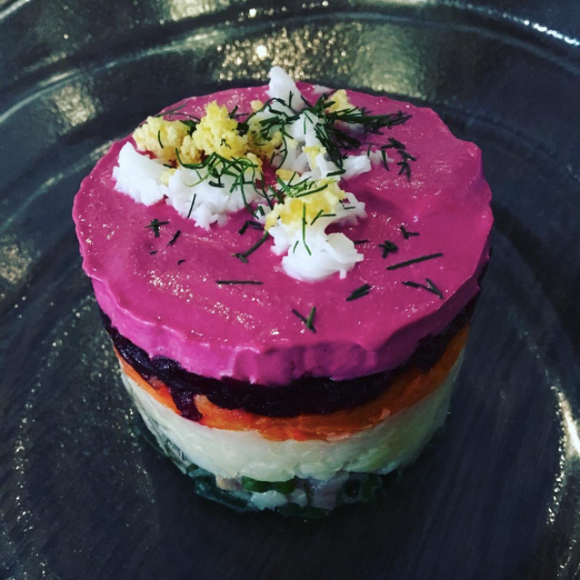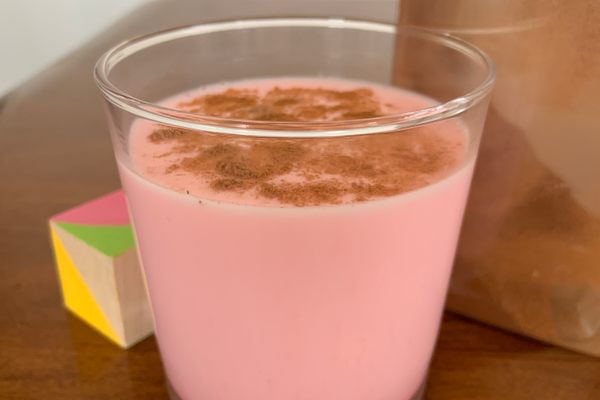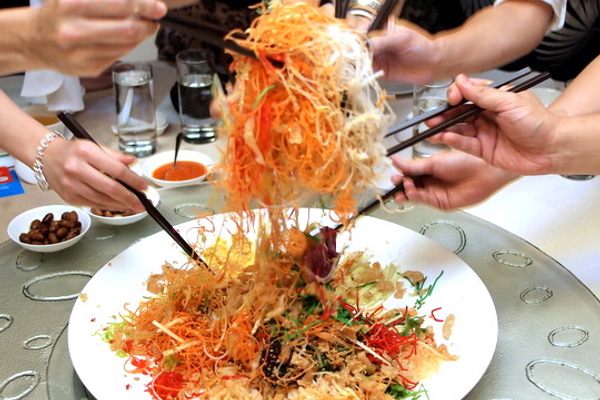According to Russian lore, the story of a beloved salad begins on New Year’s Eve, 1918.
A Moscow bar owner was fed up with his patrons drinking too much vodka, getting into fist fights, and destroying his china, windows, and furniture. The barkeeper’s solution, as the story goes, was to create a dish so hearty and irresistible that it would soak up the alcohol and leave his customers in gentler spirits. He layered starchy potatoes, fatty pickled herring, beets, and mayonnaise into a filling, colorful salad.
While it’s a great origin story, the herring salad actually dates back to a 1864 Swedish recipe. Still, it became a hit in Russia, where it came to symbolize national unity: Herring was a favorite food of the working poor, the beets added a streak of revolutionary red, and the potatoes represented farmers. Russians started calling the dish SHUBA—an acronym for a Russian political slogan condemning chauvinism, which also happened to mean “fur coat.”
But perhaps the most nationalist ingredient is mayonnaise, a particularly beloved condiment in Russia. During food shortages, mayonnaise became a popular way to a make dishes more filling. Josef Stalin was also a fan: After trying Provansal, a tangy Soviet-brand mayonnaise, he kicked commercial production into high gear.
Now eaten widely during Russian New Year celebrations and well known throughout the country, SHUBA has a colloquial name: Herring Under a Fur Coat. What began as an etymological coincidence—SHUBA meaning fur coat—became a salute to the dish’s whimsical appearance. The herring, topped with shredded beets and potatoes, appears shrouded in a heavy and bright purple fur coat.
Where to Try It
-
Masha and the Bear
771 Grand St, Brooklyn, New York, 11211, United StatesThis Russian-themed bar and restaurant serves SHUBA, along with other delicacies such as blintzes, stroganoff, and several varieties of vodka on tap.
-
Lively spot for refined Russian fare & house-infused vodkas in kitschy surroundings.
Written By
 cecilyannwong
cecilyannwong
Edited by
Sources
- www.theguardian.com/world/2014/nov/21/-sp-understanding-russias-obsession-with-mayonnaise
- www.thespruce.com/russian-herring-under-fur-coat-salad-recipe-1137331
- www.sras.org/herring_under_fur_coat
- bridgetomoscow.com/herring-under-the-fur-coat
- books.google.com/books?id=OLAHrc0gfIIC&pg=PA42&lpg=PA42&dq=russia+SHUBA+salad&source=bl&ots=JI0R7aNe0K&sig=wwWKmCzD5QtIN8HoV9RpawtOWcg&hl=en&sa=X&ved=0ahUKEwjn_7KOvPHXAhVJ0oMKHQySC6s4HhDoAQg_MAU#v=onepage&q=russia%20SHUBA%20salad&f=false
- books.google.com/books?id=wHkEAAAAYAAJ&pg=PA143&dq=%22AN+EXCELLENT+HERRING+SALAD%22&hl=en&sa=X&ved=0ahUKEwiOwK6wuPHXAhUDbRQKHb7vAewQ6AEILDAB#v=onepage&q=%22AN%20EXCELLENT%20HERRING%20SALAD%22&f=false













